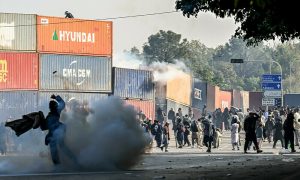On November 21, Islamabad witnessed a dramatic turn of events as the High Court directed the federal government to maintain peace at all costs. This directive came in light of the visit of the Belarusian President and a high-level Chinese delegation.
The government repeatedly urged PTI to defer its planned protests or relocate them to a less sensitive area, such as Sangjani. Despite these appeals and even extraordinary concessions, including meetings with PTI’s founder, the party chose defiance over compliance, violating court orders with impunity. 
The situation escalated when protesters, instead of heading to Sangjani, breached the Red Zone in Islamabad, one of the most secure and sensitive areas in the country. Armed with weapons such as steel slingshots, stun grenades, tear gas shells, and spiked clubs, the protesters unleashed violence on their way from Peshawar to Islamabad.
They targeted law enforcement officers performing their duty and disrupted public order, leaving behind a trail of destruction.
The use of provincial government resources, especially from Khyber Pakhtunkhwa, became evident in the logistical support provided to the protesters. Additionally, trained operatives and illegal Afghan residents were reportedly part of the mob, further intensifying the situation.
A group of 1,500 hardliners, directly under the supervision of the absconding PTI leader Murad Saeed, actively carried out militant-like attacks on law enforcement officials. This group, with its armed guards and militant strategies, showed the lengths to which PTI was willing to go to push its agenda.
Law enforcement agencies displayed remarkable restraint in the face of extreme provocation. Despite being targeted by armed protesters, including incidents where vehicles were rammed into security personnel, they refrained from using live ammunition.
Tragically, three Rangers and one police officer lost their lives, while 232 personnel were injured in these clashes. The protesters also set police vehicles on fire and caused widespread damage to public and private property.
Adding to the chaos, PTI launched a systematic propaganda campaign on social media. False narratives were constructed to blame law enforcement agencies for fabricated casualties. AI-generated videos and old clips were circulated to mislead the public and international media.
Unfortunately, certain foreign media outlets fell for this misinformation, further complicating the situation. Federal ministers and officials repeatedly clarified the reality with credible evidence, but the damage caused by the disinformation campaign was significant. 
The economic impact of this violence was staggering, with estimates of indirect losses reaching PKR 192 billion daily. The destruction of infrastructure, disruption of normalcy, and the tarnishing of Pakistan’s international image added to the already heavy toll.
However, the people of Pakistan, including those from Khyber Pakhtunkhwa, unequivocally rejected such politics of violence and division.
Despite PTI’s attempts to incite unrest, the nation stood united for peace and stability. This solidarity sent a clear message: the people of Pakistan value law, order, and harmony over chaos and propaganda. The actions of a few cannot shake the resolve of a nation determined to protect its peace and future.


